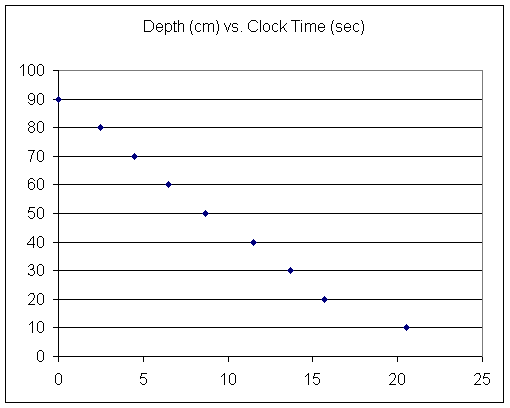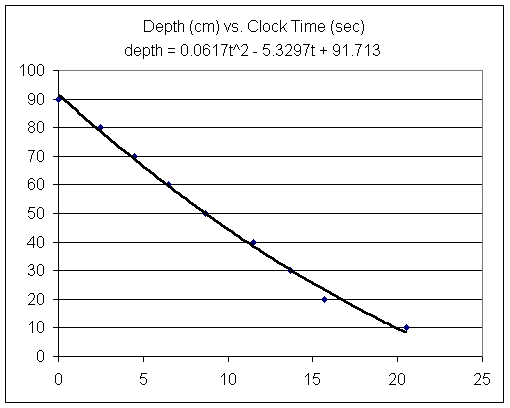
Class 0826
Depth vs. Clock Time, Initial Model
Make a table of depth vs. clock time, where clock time is the time on an imaginary clock that started at t = 0 at the instant of the first reading.
Sketch a graph of depth vs. clock time, given that with every reading depth decreased by 10 cm.
Conventions: independent variable vs. dependent variable. When graphing, the dependent variable goes on vertical or 'y' axis and independent vbl on the horizontal or 'x' axis. When making a table the independent vbl goes in the first column, the dependent in the second.
With the depth vs. clock time data taken in class we get the following graph:

Note that there was considerable inconsistency between results obtained for the same trial by different observers.
For reasons we'll be able to analyze later in the course this situation should theoretically be modeled by a depth function which is quadratic in time. So we fit our data with a second-degree polynomial.

As indicated on the graph the equation of the best-fit quadratic function is
What was depth at t = 0, 5, 10, 15, 20 sec?
| 0 | 91.713 |
| 5 | 66.607 |
| 10 | 44.586 |
| 15 | 25.65 |
| 20 | 9.799 |
| 25 | -2.967 |
At what instant was depth 0?
0.0617t^2 - 5.3297t + 91.713 = 0, or when
t = 62.65783445 or t = 23.72304074.
At what instant was depth 60 cm?
0.0617t^2 - 5.3297t + 91.713 = 60.
0.0617t^2 - 5.3297t + 31.713 = 0
At what instant was depth 30 cm?
At what average rate does this function indicate the depth is changing between t = 0 and t = 5?
Answer the same question from the intervals from t = 5 to t = 10, from t = 10 to t = 15, etc.
| -5.0212 |
| -4.4042 |
| -3.7872 |
| -3.1702 |
| -2.5532 |
If we assign the average rate to the midpoint time of the interval we get
| midpt t | ave rate |
| 2.5 | -5.0212 |
| 7.5 | -4.4042 |
| 12.5 | -3.7872 |
| 17.5 | -3.1702 |
| 22.5 | -2.5532 |
For homework, graph ave rate vs. midpt clock time and see what is the nature of that graph. Try to get an equation for that graph.